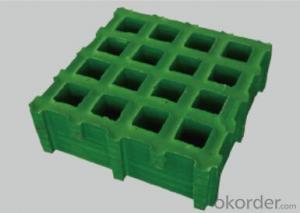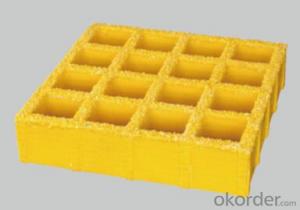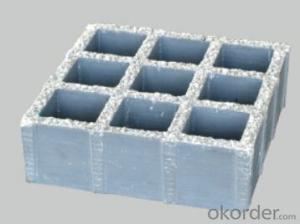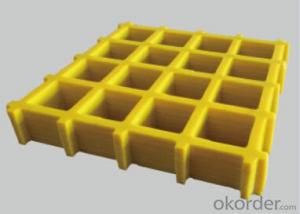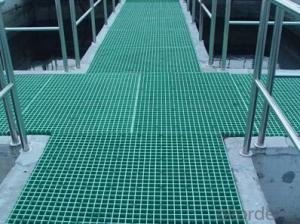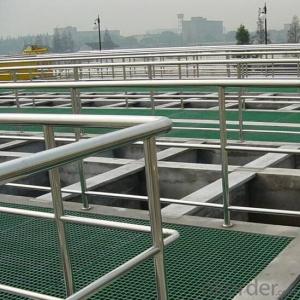FRP grating high durable corrosion in the cesspit
- Loading Port:
- Shanghai
- Payment Terms:
- TT OR LC
- Min Order Qty:
- 10 pc
- Supply Capability:
- 8000 pc/month
OKorder Service Pledge
OKorder Financial Service
You Might Also Like
Specification:
FRP molded grating made of vertical and horizontal continuous fiberglass fully soaked in unsaturated polyester resin giving perfect bi-directional mechanical properties. Combining unmatched corrosion resistance with strength, long life and safety, molded grating provide the ultimate in reliable performance, even in the most demanding corrosive conditions. Besides, it is easy to cut and install. CNBM offer the widest selection with panel sizes, colors and slip resistant surfaces, clients can avail FRP grating your specific requirements.
Product Features:
- Light but high loaded strength
- High anti-corrosion and anti-aging
- Easy installation and maintenance
- Low maintenance
- Non-conductive
- Lowest in life cycle cost
- Corrosion Resstance
- Anti-slippery
- Various sizes and color available
Colour Design:
To satisfy customer's design project, CNBM grating offers a wide selection of grating colors to choose from. The standard colors available for fiberglass grating as following:
- Blue
- Red
- Yellow
- Green
- Light Grey
- Dark Grey
Custom colors of fiberglass grating may be available upon request, you can contact us learn more.
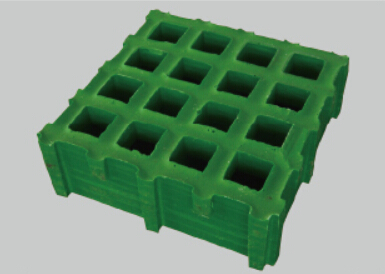

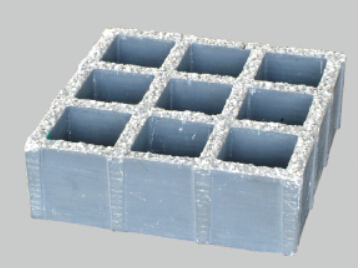

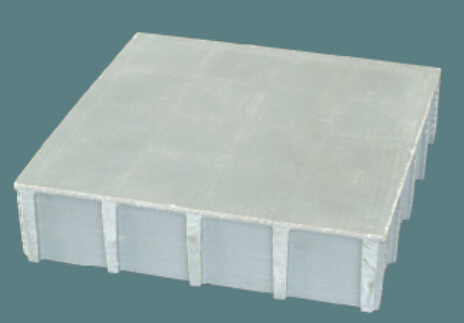

- Q:Can FRP pultrusion profiles be used in chemical processing plants?
- Yes, FRP (Fiber Reinforced Polymer) pultrusion profiles can be utilized in chemical processing plants. FRP is resistant to corrosion, chemicals, and extreme temperatures, making it an ideal material choice in such environments. Additionally, FRP pultrusion profiles offer high strength-to-weight ratio and low maintenance requirements, making them suitable for various applications within chemical processing plants.
- Q:What is the dimensional stability of FRP pultrusion profiles?
- The dimensional stability of FRP (Fiber Reinforced Polymer) pultrusion profiles is generally high. FRP materials have a low coefficient of thermal expansion, meaning they do not significantly expand or contract with changes in temperature. This property allows FRP pultrusion profiles to maintain their shape and dimensions over a wide range of environmental conditions, making them suitable for applications where dimensional stability is important.
- Q:Can FRP pultrusion profiles be used in the transportation and logistics industry?
- FRP pultrusion profiles have the capability to be utilized in the transportation and logistics sector. They possess a multitude of advantages that render them suitable for diverse applications within this industry. To begin with, FRP pultrusion profiles are both lightweight and exceptionally robust, ensuring durability. This characteristic makes them highly suitable for implementation in transportation vehicles such as trucks, trailers, and containers, where weight reduction is crucial for enhancing fuel efficiency and minimizing emissions. Despite their lightweight nature, FRP pultrusion profiles are capable of enduring heavy loads and harsh environmental conditions, thereby guaranteeing their reliability and longevity. Furthermore, FRP pultrusion profiles exhibit remarkable resistance to corrosion. Unlike conventional materials like steel or aluminum, FRP does not succumb to rust or corrosion when subjected to moisture or chemicals. This renders FRP profiles apt for applications in transportation and logistics that involve exposure to corrosive substances like saltwater, chemicals, or acidic environments. By incorporating FRP pultrusion profiles, companies can curtail maintenance expenses associated with corrosion and prolong the lifespan of their equipment. In addition, FRP pultrusion profiles offer flexible design options. They can be manufactured in a myriad of shapes, sizes, and configurations to cater to the specific requirements of transportation and logistics applications. Whether it entails structural components, platforms, flooring, or supports, FRP profiles can be tailored to accommodate diverse needs, thereby ensuring optimal performance and functionality. Moreover, FRP pultrusion profiles possess exceptional electrical and thermal insulation properties. This renders them suitable for applications in which electrical conductivity needs to be minimized or thermal insulation is necessary. Within the transportation and logistics industry, this feature can be advantageous for applications like insulation for refrigerated containers or electrical insulation for specialized vehicles. In conclusion, FRP pultrusion profiles are highly suitable for implementation in the transportation and logistics sector. Their lightweight, robust, corrosion-resistant, and customizable nature, combined with their electrical and thermal insulation properties, render them a dependable choice for diverse applications within this field.
- Q:FRP pultrusion process?
- Pultruded glass steel is mainly using unsaturated polyester resin, Yuezhanla extrusion molding process more than 90% in addition to the amount of resin, epoxy resin, vinyl resin, thermosetting resin, propionic acid modified phenolic resin, flame retardant resin etc..
- Q:Are FRP pultrusion profiles resistant to electromagnetic interference?
- Yes, FRP pultrusion profiles are generally resistant to electromagnetic interference (EMI). The use of fiberglass reinforced plastic (FRP) in pultrusion profiles provides excellent electrical insulation properties, which help to minimize the effects of electromagnetic interference. Unlike metals, which are conductive and can easily transmit electrical signals, FRP materials have high dielectric strength and low electrical conductivity. This makes FRP pultrusion profiles less susceptible to EMI and allows them to act as barriers to electromagnetic waves. Additionally, FRP materials can be further enhanced with additional layers or coatings to increase their EMI shielding effectiveness if required. Overall, FRP pultrusion profiles are a reliable choice for applications where resistance to electromagnetic interference is important.
- Q:Are FRP pultrusion profiles resistant to electromagnetic interference?
- Yes, FRP pultrusion profiles are generally resistant to electromagnetic interference (EMI). The use of fiberglass reinforced plastic (FRP) in pultrusion profiles provides excellent electrical insulation properties, which help to minimize the effects of electromagnetic interference. Unlike metals, which are conductive and can easily transmit electrical signals, FRP materials have high dielectric strength and low electrical conductivity. This makes FRP pultrusion profiles less susceptible to EMI and allows them to act as barriers to electromagnetic waves. Additionally, FRP materials can be further enhanced with additional layers or coatings to increase their EMI shielding effectiveness if required. Overall, FRP pultrusion profiles are a reliable choice for applications where resistance to electromagnetic interference is important.
- Q:What are the different types of FRP pultrusion profiles available?
- Some of the different types of FRP pultrusion profiles available include standard shapes such as I-beams, channels, angles, and tubes. Additionally, there are custom profiles that can be designed and manufactured based on specific project requirements.
- Q:Can FRP pultrusion profiles be used in the renewable energy and solar power industry?
- The renewable energy and solar power industry can effectively utilize FRP (Fiber Reinforced Polymer) pultrusion profiles. These profiles possess several key characteristics that make them ideal for such applications. To begin with, the high strength-to-weight ratio of FRP pultrusion profiles is crucial in the renewable energy sector. They are lightweight yet strong, allowing them to withstand various environmental conditions while remaining cost-effective. Additionally, these profiles offer excellent corrosion resistance, ensuring durability and longevity in outdoor and potentially corrosive environments like solar power plants or wind farms. Moreover, FRP pultrusion profiles have outstanding electrical insulation properties, making them suitable for electrical applications commonly found in the renewable energy industry. Furthermore, these profiles can be easily customized into various shapes and sizes, enabling the design and engineering of complex structures required for solar power installations or wind turbine blades. Furthermore, FRP materials are non-conductive and non-magnetic, ensuring their safety for use in electrical and magnetic fields associated with renewable energy systems. In conclusion, FRP pultrusion profiles provide a combination of strength, durability, lightweight, corrosion resistance, and electrical insulation properties that make them highly suitable for use in the renewable energy and solar power industry.
- Q:Can FRP pultrusion profiles be used in the construction and building materials industry?
- FRP pultrusion profiles are indeed applicable in the construction and building materials sector. These profiles are created by pulling continuous fibers through a resin bath and then into a heated die, which aids in curing the resin and shaping the profile. One of the primary advantages of FRP pultrusion profiles lies in their exceptional strength-to-weight ratio. Despite being lightweight, they possess incredible durability and strength, making them an optimal choice for construction purposes where weight reduction is desired. Moreover, FRP pultrusion profiles exhibit outstanding resistance to corrosion, which proves particularly advantageous in environments with moisture, chemicals, or harsh weather conditions. This corrosion resistance extends the lifespan of building materials, thereby reducing maintenance and replacement expenses. FRP pultrusion profiles can serve a wide array of construction applications, including structural components like beams, columns, and trusses. They are also frequently utilized as reinforcements in concrete structures, offering added strength and durability. Additionally, these profiles find utility in cladding, decking, handrails, ladders, and other non-structural elements within buildings. Furthermore, FRP pultrusion profiles provide design flexibility as they can easily be customized and manufactured to specific shapes, sizes, and properties. This adaptability renders them suitable for diverse construction projects, ranging from small-scale residential buildings to large-scale industrial complexes. In conclusion, FRP pultrusion profiles are highly appropriate for the construction and building materials industry due to their superior strength-to-weight ratio, corrosion resistance, design flexibility, and versatility.
- Q:Are FRP pultrusion profiles resistant to weathering?
- Yes, FRP pultrusion profiles are highly resistant to weathering. The pultrusion process creates a strong, durable, and non-corrosive material that is inherently resistant to various weather conditions. FRP (Fiber Reinforced Polymer) profiles are composed of a combination of fiberglass reinforcements and a thermosetting resin matrix. This unique composition provides excellent resistance to UV radiation, moisture, chemicals, and temperature fluctuations, making them ideal for outdoor applications. FRP pultrusion profiles have been extensively tested and proven to maintain their structural integrity and physical properties even after prolonged exposure to harsh weather conditions. They do not degrade, warp, or crack due to sunlight, rain, snow, or extreme temperatures, unlike traditional materials like wood or metal. This weather resistance allows FRP pultrusion profiles to be used in a wide range of applications, including construction, infrastructure, marine, and transportation industries. Furthermore, FRP pultrusion profiles have a low thermal expansion and contraction rate, ensuring dimensional stability in fluctuating weather conditions. This characteristic prevents the profiles from warping or distorting over time, making them an excellent choice for long-term outdoor use. In summary, FRP pultrusion profiles are highly resistant to weathering and offer long-lasting durability in various outdoor environments. Their ability to withstand UV radiation, moisture, chemicals, and temperature fluctuations makes them a reliable and cost-effective solution for a wide range of applications.
1. Manufacturer Overview |
|
|---|---|
| Location | |
| Year Established | |
| Annual Output Value | |
| Main Markets | |
| Company Certifications | |
2. Manufacturer Certificates |
|
|---|---|
| a) Certification Name | |
| Range | |
| Reference | |
| Validity Period | |
3. Manufacturer Capability |
|
|---|---|
| a)Trade Capacity | |
| Nearest Port | |
| Export Percentage | |
| No.of Employees in Trade Department | |
| Language Spoken: | |
| b)Factory Information | |
| Factory Size: | |
| No. of Production Lines | |
| Contract Manufacturing | |
| Product Price Range | |
Send your message to us
FRP grating high durable corrosion in the cesspit
- Loading Port:
- Shanghai
- Payment Terms:
- TT OR LC
- Min Order Qty:
- 10 pc
- Supply Capability:
- 8000 pc/month
OKorder Service Pledge
OKorder Financial Service
Similar products
New products
Hot products
Related keywords
